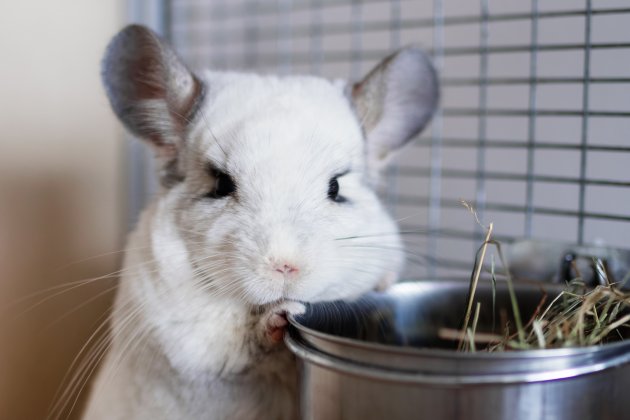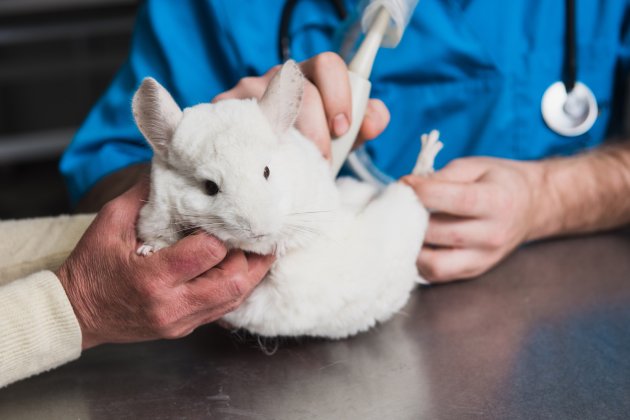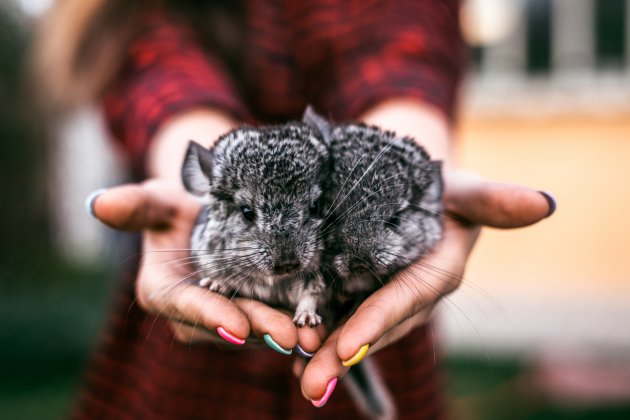With their super-soft fur, big ears, and appealing cuddly roundness, Chinchillas have the looks of a living plush toy. But these cute looks are at odds with their needs, because Chinchillas are anything but a child’s pet, and are best suited to adult owners.
Shy but sociable, Chinchillas are not robust creatures. Many of their health problems are due to simple misunderstandings about their needs, so keep your Chinchilla fit and happy by being aware of these 10 common health problems.

#1: Heat Stroke
How would you feel wearing a thick fur coat on a hot summer’s day?
That impressive Chinchilla coat is marvellously effective at retaining warmth. The downside is they are poorly equipped to cope to lose heat and struggle with temperatures above 27C. Chinchillas are prone to heat exhaustion and prefer to live in temperatures below 20C.
Signs of heat stroke include:
- Flushed pink ears
- Panting
- Rapid breathing
- Reluctance to move
- Feeling warm to the touch
Treat this as an emergency and immediately remove the Chinchilla to a cool place. Wet their fur with cool (not freezing) water and have a fan blow air over them.
#2: Sore Feet
Also known as ‘pododermatitis’ Chinchillas can suffer from sores on the soles of their feet. If this inflamed skin becomes infected, not only is it painful but it can lead to blood poisoning.
The commonest cause is having metal mesh cage bottoms, an abrasive exercise wheel, or not enough bedding. Prevention is best by providing a solid floor, regularly checking the wheel, and ensuring plenty of Chinchilla-safe, soft bedding.
#3: Broken Bones
The disproportionally long hind legs of the Chinchilla give them impressive jumping ability. However, their bones are light and, unfortunately, fragile. A frightened Chinchilla that jumps from their owner’s arms is liable to break a leg with serious consequences.
An additional concern is that Chinchillas grip food with both hands to feed themselves. If one ‘arm’ is broken, they may struggle to eat, gradually lose strength, and waste away. Again, prevention is best by learning how to safely handle a Chinchilla.

#4: Hairy Situations
Chinchillas don’t like humid conditions. In a damp environment, their skin immunity is weak, which means picking up skin infections such as ringworm.
Signs include:
- Patchy hair less
- Reddened scaly skin
- Their owner may become infected and have round, red patches of skin.
If you suspect ringworm, take your Chinchilla to the vet. It’s important to get a treatment that’s safe when the Chinchilla grooms themself.
Likewise, stress can cause the Chinchilla to shed heavily and develop a patchy coat. Speaking of which, ingested fur can stick together in the gut to form hair balls. In the worst cases, this can cause a blockage causing loss of appetite and could be fatal.
#5: Respiratory Problems
Chinchillas have delicate respiratory systems and a simple cold can rapidly snowball into pneumonia.
Signs include:
- A hunched appearance
- A discharge from the eyes or nose
- Rapid breathing
- Loss of appetite
May sure the enclosure is spotlessly clean and dry. Remember what we said about humidity? Well, a humid environment weakens their chest and predisposes to infection. Make sure there is good ventilation with clean fresh air, and the Chinchilla is kept in spacious, stress-free surroundings.
#6: Infected Wounds
A stressed Chinchilla is a grouchy Chinchilla that may be aggressive to their cage mates. Bite wounds easily become infected and develop into an abscess: this is a swelling or lump that is full of pus.
Keep fresh wounds clean by bathing with weak salt water. But if the area is swollen, always see the vet. The abscess may need to be lanced, and a course of antibiotic required to fight the infection from the inside out.

#7: Swollen Stomach
An accumulation of gas in the gastro-intestinal tract is known as bloat, and sadly this is relatively common in Chinchillas. This is because healthy digestion depends on the correct balance of bacteria in the gut and regular muscular contractions of the gut wall. Anything that disturbs or stresses the Chinchilla (such as a sore tooth or over-crowded conditions) leads to a release of hormones that causes the gut to stop working (Gastric stasis). When this happens, the bacteria get out of balance and digestion is disturbed.
Bloat and/or gastric stasis can kill in an alarmingly short time. Again, providing a relaxed stress free home and meeting all the Chinchilla’s needs are the best way to avoid this distressing condition.
#8: Rectal Prolapse
This serious condition occurs due to either diarrhoea or constipation. Straining to pass pellets causes an increase of pressure in the belly, which can push the rectum outside the body.
Surgical replacement of the prolapse is rarely successful and euthanasia is often the kindest option.
#9: Digestive Disturbance
Chinchilla digestion is a delicate balancing act that relies heavily on bacteria in the gut. These bacteria need time to adjust to a change of food, and not to do results in diarrhoea. So avoid sudden changes in diet and be sure to give your Chinchilla plenty of fibre.
But diarrhoea is just a symptom of digestive disturbance. To make matters more complicated, stress can inhibit the digestive process, resulting in diarrhoea. Plus, those helpful bacterial are sensitive to antibiotics, so careful thought must always be given to the appropriate treatment when a Chinchilla is sick for some other reason.
#10: Dental Disease
And last but not least, dental disease is a common source of ill health. Signs of sore teeth include:
- Weight loss
- Messy eating and dropping food out of the mouth
- A wet chin and chest
- Drooling bloody saliva
- Lack of faecal pellets
Tooth problems are common because Chinchilla teeth are open-rooted, meaning they grow all-the-time, just like our fingernails. This growth is balanced by the wear-and-tear of chewing high fibre food. But if the Chinchilla’s diet is too soft, the teeth grow faster than they wear out, leading to spikes and spurs.
Also, a diet that’s too low in calcium leads to poor quality teeth and bones, which can mean pain and increased risk of dental abscesses.
If you suspect your Chinchilla has sore teeth, a vet visit is essential. They can check the cheek teeth using an otoscope, and if necessary anaesthetise the Chinchilla to trim the teeth into shape.
Owning a Chinchilla means being savvy about their care and researching their needs. Do this and the reward is a happy and healthy fur-friend that makes a delightful pet.
Further reading:
- Dan H. Johnson, DVM, DABVP-ECM. Gastrointestinal stasis syndrome in small herbivores
- Cathy A. Johnson-Delaney, DVM, Dipl ABVP (Avian). Anatomy and Physiology of the Rabbit and Rodent Gastrointestinal System